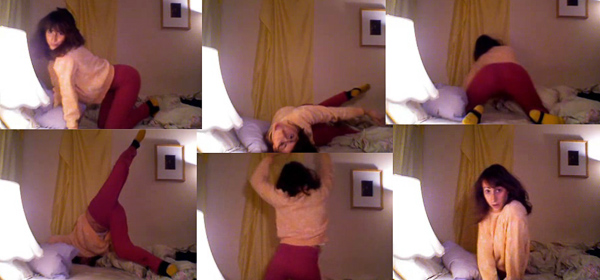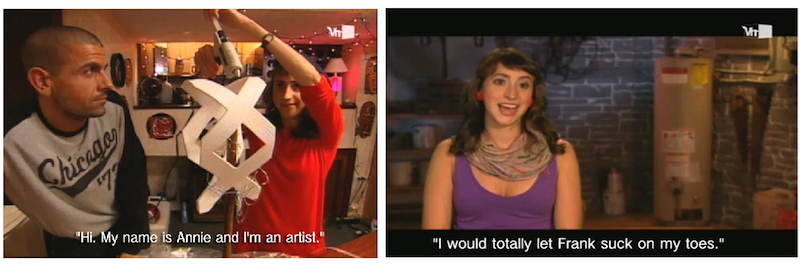Résumé
Cet article propose un cadre critique facilitant l’appréciation de la performance contemporaine queer en ligne. Traitant de la façon dont les corps sont en partie formés par la culture, et plus fortement par certaines forces technico-idéologiques à l'ère des réseaux, il examine comment ces forces structurent les pratiques de l’imagerie du soi. L’article s'appuie sur une lecture des œuvres d’Ann Hirsch et de Georges Jacotey et soutient que leurs performances queer œuvrent contre la production d’identités codées et conditionnées par la culture numérique.
For many of us, digital tools shape how we imagine ourselves in daily life: from checking-in to social media networks, texting, webcamming, geolocative tracing, and of course in the taking of selfies. What emerges from these common practices is an imperative to think of, to visualize, and indeed to perform ourselves along technological lines. That is, we have come to understand ourselves in terms of digital media.
This is not particularly new: technologies have often encoded contemporaneous cultural imaginaries about the body. Evoking Marshall McLuhan, the theologian David Lochhead once wrote: “we create machines in our own image and they, in turn, recreate us in theirs.”[1] In contemporary technoscience and cybernetic culture, metaphors of computers have been applied to understand the body. Here we find not the innocuous claim that people are like computers, but rather the brash insistence that we, in fact, are digital machines. This computationalist lens has developed the widespread sentiment of the body in digital terms, where the 'software' of the mind is posed against the body as crude 'hardware', to conceive of the self in the vulgarized terms of mere information processes. McLuhan warned of this loss of the body, and the related loss of identity that came about with the electronic age.[2] With current network technologies, though, the body has demonstrably not dematerialized, but has in fact been subjected to a styling that requires its hyper visibility.
And so, we may look toward digital imagery of the body to sense how it performs within the impoverished systems of representation afforded in digital culture. We can turn to practices through which individuals perform their selves through the techniques available within a given cultural discourse. This is what Foucault called Technologies of the Self, and is here what I appropriate to think of some artworks by Ann Hirsch and Georges Jacotey as Queer Technologies of the Selfie
I. Network Performance
The network age extends the computational view of self to render the physical body as an obsolete chunk of fleshy hardware.[3] Consider that the Internet was sold as a tool of liberation—as a technology that would allow us to transcend our merely mechanical bodies, and join some posthuman, transnational stage. This bill had a decidedly emancipatory tone, and “significantly,” as network theorist Wendy Chun discerns, this view “of the Internet as emancipator, as “freeing” oneself from one’s body, also naturalized racism.”[4] Far from lifting the constraints of race, sex, gender, class, etc., cyberspace has relentlessly underscored cultural imperatives geared toward androcentric, white, heterosexuality. This is maintained precisely through coding: both computer code, and what Judith Butler would describe as culturally repeated codes,[5] those performative means of embodying ideological forces. We can see this at the level of the body, and through imagery routinely used to represent it.
JenniCam, Checking-in & Societies of Control

Jennifer Ringley. webshots from Jennicam. 1996-2003.
One of the web's earliest lifecasters, Jennifer Kaye Ringley broadcasted live imagery from her apartment continuously between 1996-2003. Nearly twenty years ago—well before checking-in to digital networks became commonplace, Ringley performed check-ins. Through setting up a system for the automated imaging of the self, she regularly checked-into the system, and checked-in her own body. Such checking-in has become prosaic, as many of us register our bodies within technological systems as a continual practice throughout daily life.
This mode of performance entails a certain quantifiable view of the self: the self as data set—a systematic image of our bodies. And such ordering of the self-image is indicative of a form of control that has come about in the digital age—what Deleuze characterized as the control society.[6] This is not the chain of discrete states of confine that characterized Foucault's disciplinary societies, but a continuous and unbounded system of free-floating control. It is an incomplete and open system into which we each check-in: we opt into these systems for the apparent freedom they seems to afford us. Facebook, as an axiomatic example, allows me to create a self-image however I see fit, yet it demands participating along its rigid protocols.
And so, images of the self produced for circulation within digital networks style the body along particular technological affordances. “Doing one's body” online, (to appropriate Butler's phrasing[7]) means imaging the self with an impoverished range of representational tools, and checking-in to its protocols. My image of myself is literally a bitmap—electronic code—snapped, uploaded and tagged. This extends in turn to new, mediated social realities, which rely on continual check-ins. Here, we chase an ideal of self-actualization that produces an image of the self as informed, linked-in, and desirable. We gain visibility by participating in these systems—so much so that they actually constitute selfhood: if one is absent within the purview of a system—if one fails to check-in—one is rendered invisible and outside of a social reality. For many, if an experience is not presented on one's Facebook wall or Twitter feed, it simply did not happen within the social register. Here, as Geert Lovink articulates: “to live a tweetless life is constructed as not living.”[8]
This system encourages a mere posing of the self as social: a posturing of the self-image as networked. Paradoxically, as Sherry Turkle elaborates, “we are increasingly connected to each other but oddly more alone.”[9] Here, vulgar forms of communication limit the depth of our networked connections: “the emoticon emotions of texting signal rather than express feelings.”[10] Reversing a setup where digital tools augment a social life, online protocols encourage a life defined in digital terms. Living is construed as a continual performance for the system, and as the creation of an image of the self in digital form. Hence, much of the mainstream modes of imaging the self online render social experience diminished to short-lived forms of self-marketing, in which we perform certain codes to posture our bodies as linked-in, and also as desirable representations. In some instances this means passing as some gendered ideal, or rendering the self as fuckable.
In the face of these domineering forces, we may ask questions concerning how and where queer sensibilities can affect critical mediations within digital networks. Is there room for what Foucault described as self-styled acts, which would allow for a more radical self-imagery? Or are we proscribed into a rigid technical protocol and coding that Butler characterizes as the mundane repetition of stylized acts?[11] To deepen our approach we may look to some young artists who are asking these questions.
II. Queer Selfies
a. Ann Hirsch

Ann Hirsch. Stills from The Scandalishious Project (Caroline + Heart), 2008-9. YouTube performance. Permission of Ann Hirsch.
The American artist Ann Hirsch has developed multiple, self-created 'characters' that perform through online video and social media. Each are distinct from each other, yet each ambiguously overlaps with the 'actual' identity of the artist, which is to say, her day-to-day, 'out of character' self. Some years ago, Hirsch assumed the role of a camgirl, as Caroline, aka Scandalishious.[12] Caroline was a teenage college freshman pursuing attention through video postings of herself dancing, giving fashion advice, or opening up to emotional confessions. Some of Caroline's more popular videos garnered tens of thousands of views, and cumulatively they reached over two million hits. In a more recent set of enactments, Hirsch has performed as Jason Biddies to produce web-cam diaries, public lectures and social media activity, and actively underscores his own white, lower-middle class, straight dudeliness.[13]

Ann Hirsch. Stills from Frank the Entertainer... in a Basement Affair, 2010 VH1. Permission of Ann Hirsch.
In 2010 Hirsch performed as Annie, one of 15 contestants vying for the attention of minor reality TV celebrity Frank Maresca on VH1's dating contest "Frank the Entertainer..."[14] Annie was a manipulation of the reality television medium, and an embodiment of the trope of the 'kooky artist' that allowed Hirsch's casting in the production. She performed in character from the show's audition and throughout the filming, and outed herself only subsequently in a series of articles in BUST magazine, called Shaming Famewhores. She wrote of her intentions: “to play up the ridiculousness that is reality television and the characters it produces, a satire on a genre that is already a satire of itself.” “But ultimately,” She goes on to admit, “I wanted to become a Famewhore. I’ve been drawn to Famewhores for as long as there has been trashy reality television, socialites releasing sex tapes, since the first woman shook her ass on YouTube. I was there, watching and wondering.”[15]
And so, what took place during the TV show production was the development of a complex persona, as Hirsch's initial intentions were derailed. She has said: “Performing a character is more or less what many contestants are doing anyways, just not under the guise of art critique.” Throughout the show's production, she found herself actually attracted to the protagonist, and found that the identity she developed—Annie—shifted away from a purely artificial creation, to a self-image that weirdly merged a projected and an embodied being—what she has called her “reality TV self.” Annie and Ann became indistinguishable from each other.
Throughout Hirsch's performances we can read a self-reflexive engagement with mediatized identity production. It seems apparent that Hirsch has developed parodic, inverted imitations, that infiltrate and overidentify with the normative protocols of performing within certain media-forms. She seems to rob these protocols of their of their authority, and their insistence on the performative repetition of behaviours culturally coded toward gendered, sexed, classed ends. Hence, Annie appears to be that predictable, vapid reality-TV character —but only in moments. In others, she bends and breaks the codes by which that character is expected to behave. This would be parody as a critical mode by which discursive standards can be flexed away from their chauvinist bearings.

Ann Hirsch. Stills from Frank the Entertainer... in a Basement Affair, 2010 VH1. Permission of Ann Hirsch.
Hirsch's performed identities, though, are not merely parodic—as inversions of the norm—but are unstable, complex images of the self, that find basis in the fragmented, multiplicative context of digital culture. Any cohesive identity—that of the artist, of her 'characters'—seems to spin out. These are no mere parodic transgressions of authoritative protocols, but rather something of a slippery fish—identities beyond the mere codes they inhabit, that nonetheless participate within them.
b. Georges Jacotey

Georges Jacotey. Rehearsal Selfies from Son of a Patriarch. 2013 Permission of Georges Jacotey
Unlike Hirsch's multiple, fractured identities, the Greek artist George Jacotey has developed a single, stylized, sexual, at times comic, and arguably camp persona. This has been developed in live and recorded video performances in which we see Jacotey act out gestural and expressive movements, often using rudimentary visual effects of web-cam add-on software, and often delivering long, melodramatic monologues. Frequently, he is shirtless. Sure, he is in a hot climate, but is also evidently conveying a certain erotic pathos in his self-image.
This sexualization of the self-image is the primary focus of Jacotey's work, seen across all of his creative productions, from stripteases to karaoke, and even in a video where he simply cries in front of his web-cam.[16] In last year's sth I never intended confessing to u,[17] we see a recurring trope from his videos and performances, as he licks at then fellates some sort of ice-cream product that comes in a push-tube.

Georges Jacotey, still from sth I never intended confessing to u, 2013. video, 17:00. Permission of Georges Jacotey.
In these sexualized acts, but also, indeed, in every moment of his performances, Jacotey moves his body sensually, gestures for the camera, and flirts with his eyes: exhibiting either the virtuosity of a seasoned actor, or the self-consciousness of a kid who grew up engaging in cybersex. Jacotey clearly targets prominent practices and mannerisms of masculine sexuality, and works to push against the imagery most associated with male heterosexuality—to push against this imagery and, as he tells us in one YouTube description, against the “dominant visual and linguistic representations [that] reinforce fixed binary gender identities and accepted behaviours.”[18] Expressly, he performs queer gestures remarkable for their departure from performative gender norms.

Georges Jacotey. still from 2night Im gonna cum 4u(see my face as I cum for you internet), 2013. CAM4 broadcast; video, 30:00. Permission of Georges Jacotey.
2night Im gonna cum 4u(see my face as I cum for you internet)[19] is a half-hour long, live striptease of sorts broadcast on the amateur web-cam exhibitionist platform Cam4, and documented as a video. In it, we see Jacotey alone in an interior—dancing to European techno, R&B, and hip-hop, then drawing on top of his projected image, and finally masturbating himself until a climax when we see only a close-up of his rapt face, and the ecstatic drop of his webcam, as he apparently loses control of his image. Jacotey has characterized the work as one of many projections of identity made possible by the Internet,[20] and it is evocative of widespread millennial-generation explorations of the self within digital networks.
It is here that Jacotey develops a fundamental ambiguity: not merely opposed to socio-technical protocols, but actively engaging them, when he consciously adopts the image of a fuckable, feminized, sexualized gay man. But at the same time, it seems that he actually feels sexy. We see a consciously effete behaviour—but not adopted as a masquerade—it is not, say, the camp and hyper-feminine mannerisms of drag—but is rather a self-styled performance of his own sexuality. I would argue that Jacotey, as with so many of us fags of the Internet-generation, has developed a sexual subjectivity in tandem with other individuals, and with the communications technologies that connect us. Jacotey's artworks come out of a lived practice in which the production of self-images is commonplace. That is to say, his constructed self-image is never separate from his projected image. And so questions of how ironic or sincere he is may here miss the point. He calls attention to the mediatized representational apparatus as it exists at the site of his own body. But at the same time he exercises his own desire within it— as he performs a very playful, and very queer embodiment of gendered gestures.
Conclusion: Queer Intentions
To reiterate, Hirsch and Jacotey do not fully embody tactics of parody and camp that would locate these artists in opposition to protocols of imaging the self in digital culture. Rather, they perform a more unsettling complicity within these protocols to allow for the expression of complex processes of self-identification. These performances are characterized by an intimate investment in mediatized identity production that allows for poignant explorations of gendered and sexualized states of being. In moments, these artists have been able to transgress certain technical confines—binary, and Cartesian, as they are—and break from the grid of order imposed by techno-social regimes. In doing so, they have given space for what Eve Sedgwick calls the “lapses and excesses of meaning”—that “open mesh” that characterizes queerness.[21] It is precisely through performing within these systems—though iterating subject states—staging identities in networked digital media—that they accomplish this. This plays out, clearly, on their bodies—sexualized, raced, gendered, and technologized as they are.
Sources
Butler, Judith. Gender Trouble: Feminism and the Subversion of Identity. New York; London: Routledge, 1990.
---. “Performative Acts and Gender Constitution: An Essay in Phenomenology and Feminist Theory.” Theatre Journal, Vol. 40, No. 4. (1988): 519-531.
Chun, Wendy Hui Kyong. Control and Freedom: Power and Paranoia in the Age of Fiber Optics. Cambridge, MA, MIT, 2006.
Deleuze, Gilles. “Postscript on the Societies of Control.” October 59, Cambridge, MA: MIT. (Winter 1992): 3-7.
Foucault, Michel. “Technologies of the Self.” edited by Luther H. Martin, Huck Gutman and Patrick H. Hutton., Univ. of Massachusetts Press, 1988.
---. The History of Sexuality. New York: Pantheon, 1978.
Hirsch, Ann. “Shaming Famewhores Part I: On Becoming a Famewhore.” BUST Magazine, 25 Jan. 2010, 08 Apr. 2014.
Lochhead, David. "Technology and Interpretation: A Footnote to McLuhan." Journal of Theology, Jan. 1994.
Lovink, Geert. Networks Without a Cause: A Critique of Social Media. Cambridge, UK: Polity, 2011.
Lupton, Deborah. ‘The Embodied Computer/User,’ in Bell, D & Kennedy, B (Eds) The Cybercultures Reader. London: Routledge. 2000.
McLuhan, Marshall, MatieMolinaro, Corinne McLuhan, and William Toye. Letters of Marshall McLuhan. Toronto: Oxford University Press Canada, 1987.
Sedgwick, Eve Kosofsky. Tendencies. Durham: Duke University Press, 1993.
Turkle, Sherry. Alone Together: Why We Expect More from Technology and Less from Each Other. New York: Basic, 2011.
Notes
[1] David Lochhead, “Technology and Interpretation: A Footnote to McLuhan,” Journal of Theology (Jan. 1994).
[2] McLuhan's alarmism over increasing 'discarnetism', or electronic disembodiment that produces robotic states, is most explicit in his personal letters to heads of state. i.e. his 1977 letters to Jimmy Carter and Pierre Trudeau. See Marshall McLuhan, Matie Molinaro, Corinne McLuhan, and William Toye, Letters of Marshall McLuhan (Toronto: Oxford University Press Canada 1987).
[3] “The dream of cyberculture is to leave the "meat" behind and to become distilled in a clean, pure, uncontaminated relationship with the human body.” Deborah Lupton ‘The Embodied Computer/User’ in Bell, D. & Kennedy, B. (Eds) The Cybercultures Reader (London: Routledge, 2000): 479.
[4] Wendy Hui Kyong Chun, Control/Freedom: Power and Paranoia in the Age of Fiber Optics (Cambridge, MA: MIT, 2006): 132.
[5] This is the central claim in her 1988 “Performative Acts and Gender Constitution: An Essay in Phenomenology and Feminist Theory,” Theatre Journal. Vol. 40, No. 4. (1988): 519-531.
[6] Giles Deleuze, “Postscript on the Societies of Control,” October 59, Cambridge, MA: MIT. Winter (1992): 3-7.
[7] Judith Butler, “Performative Acts and Gender Constitution: An Essay in Phenomenology and Feminist Theory,” Theatre Journal, Vol. 40, No. 4. (1988).
[8] Geert Lovink, Networks Without a Cause: A Critique of Social Media (Cambridge, UK: Polity, 2011) 44.
[9] Sherry Turkle, Alone Together: Why We Expect More from Technology and Less from Each Other (New York: Basic, 2011): 19.
[10] Turkle, 225.
[11] Judith Butler, Gender Trouble: Feminism and the Subversion of Identity (New York; London: Routledge. 1990) 179.
[14] After the broadcast run, the performance resulted in subsequent videos and a MySpace profile, and a performance lecture How to get on Realty TV, Flux Factory, 2011.
[15] Ann Hirsch, “Shaming Famewhores Part I: On Becoming a Famewhore,” BUST Magazine. 25 Jan. 2010. 08 Apr. 2014.
[16] Melodramatic Diary, 2010.
[18] Jacotey, Georges. "Son of a Patriarch." Vimeo. Nov. 2013. Web. Apr. 2014.
[21] Eve Kosofsky Sedgwick, Tendencies (Durham: Duke UP, 1993): 8.
Mikhel Proulx est un chercheur culturel intéressé par l'art contemporain et la performance, les études critiques d’Internet, ainsi que les cultures visuelles numériques. Ses oeuvres d'art et ses projets de commissariat ont été présentés au Canada, aux États-Unis, en Allemagne, en Autriche et à Jérusalem. Il est titulaire d'un diplôme de premier cycle en dessin de l’Alberta College of Art and Design et d’une maîtrise en histoire de l'art de l'Université Concordia, institution où il développe actuellement son doctorat au Centre for Interdisciplinary Studies in Society and Culture.
